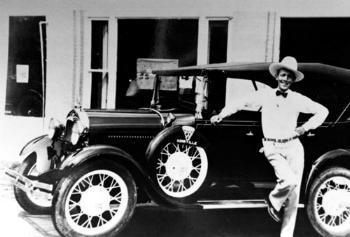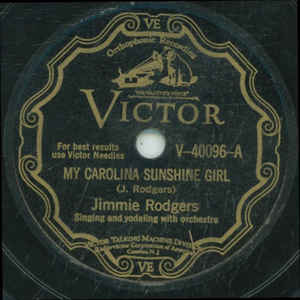Jimmie Rodgers
“Rodgers was known for yodeling and the drinkin', cheatin', and fightin' side of country music.”
If the Carter Family represents the side of country music focused on “God, mom and apple pie,” Jimmie Rodgers provided listeners with the “drinkin’, cheatin’, and fightin’” side of things. Although the Carter Family didn’t shy away from frank descriptions of lost love and hard times, such as their first hit, Single Girl/Married Girl, they didn’t tend to sing songs about things like prison, murder, and so forth. While the Carters had been farmers prior to their career in music, Jimmie Rodgers came to the “hillbilly” scene as a seasoned professional performer with lots of experience with blues, popular songs, and hillbilly music. Rodgers was also famed for his yodeling, a vocal technique that is found in various European folk traditions as well as in some African-American styles.
Rodgers can also be credited with popularizing the blues within country music, and many of his songs are built on the 12-bar blues progression. He augmented this with his trademark “blue yodel.” In the film clip above, Rodgers presents himself as an itinerant railroad worker and sings three of his hit songs. They’re all stellar, but I would direct your attention to the last song “Blue Yodel No. 1 (T for Texas).” This tune is a standard 12-bar blues progression with short sections in-between in which Rodgers adds his blue yodel. The lyrics are in some ways fairly standard for the blues, dealing with lost love and murderous revenge…although with the assurance that Rodgers can still get more women “than a passenger train can hold.”
“Rodgers can be credited with popularizing the blues within country music, and many of his songs are built on the 12-bar blues progression.”
The introduction of the blues to country music is a reminder that country music has melded different influences from the beginning (although we might say the same about any musical style really...advocates of musical "purity" typically have rather short memories). Rodgers actively cultivated such musical crossovers not only by playing blues but also by enlisting jazz musicians on several songs, including Louis Armstrong (trumpet) and Lil Hardin Armstrong (piano) on “Blue Yodel No. 9” (1932) and a full Dixieland combo on “My Carolina Sunshine Girl” (1928). Over the 20th century, Rodgers has been the model for male country singers, and his influence is especially apparent on honky-tonk stars like Hank Williams. A number of black blues artists also cite Rodgers as a formative influence, perhaps a further reminder that even though we tend to associate musical styles with particular ethnicities, the realities of history are often much more fluid and complex. The situation also illustrates one of the critical advantages of recorded music: its portability causes it to quickly transcend its intended audience.
Jimmie Rodgers’ incorporation of jazz and blues styles perhaps also foreshadows one of the continuing debates within country music, namely to what extent it should stick to its traditional roots as opposed to incorporating and reflecting the popular trends of the time. This question dogged 30s/40s Western Swing artists like Bob Wills, who further incorporated jazz styles and instruments like trumpets and drum kits (along with a dash of Mexican mariachi and Hawaiian lap guitar), electric honky-tonk artists like Ernest Tubb and Hank Williams, and 1970s country-pop stars John Denver and Glen Campbell. Major stars of the 1990s like Billy Ray Cyrus and Garth Brooks transformed country music into a big-time showbiz spectacle, complete with massive arena concerts and choreographed line dances. More recent pop-country stars (Taylor Swift, Keith Urban, etc.) and collaborations between country artists and R&B singers and rappers are just the latest entries in the same cycle. But perhaps any musical style that claims to have one foot in “tradition” (however that’s defined) is setting itself up for a more-or-less permanent state of crisis, especially if it becomes widely popular.

